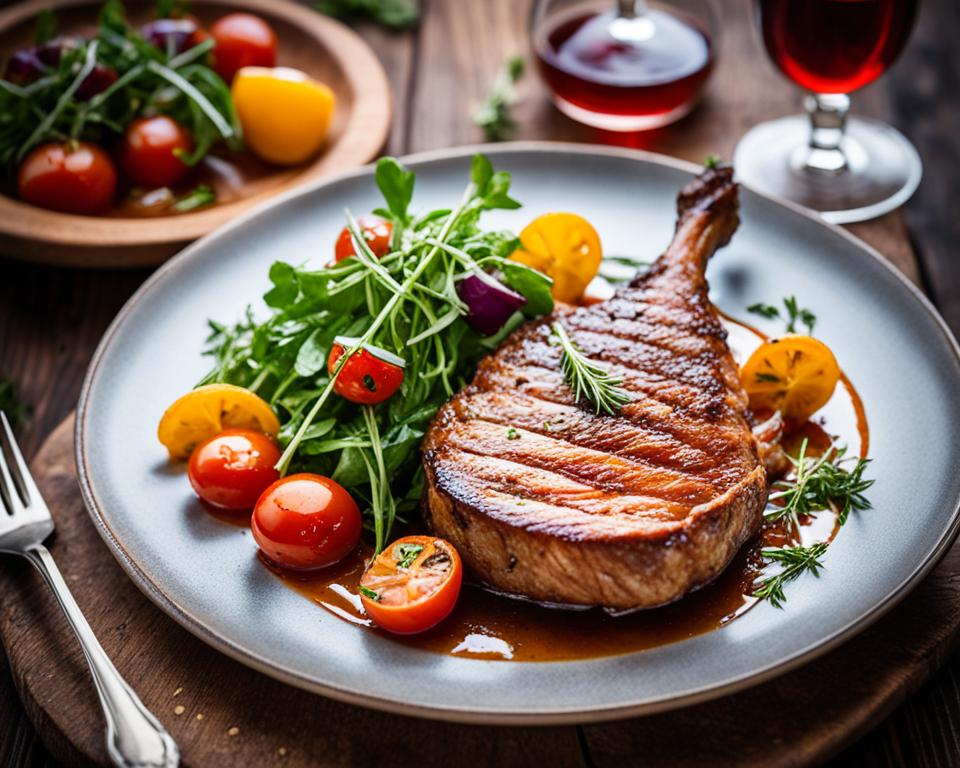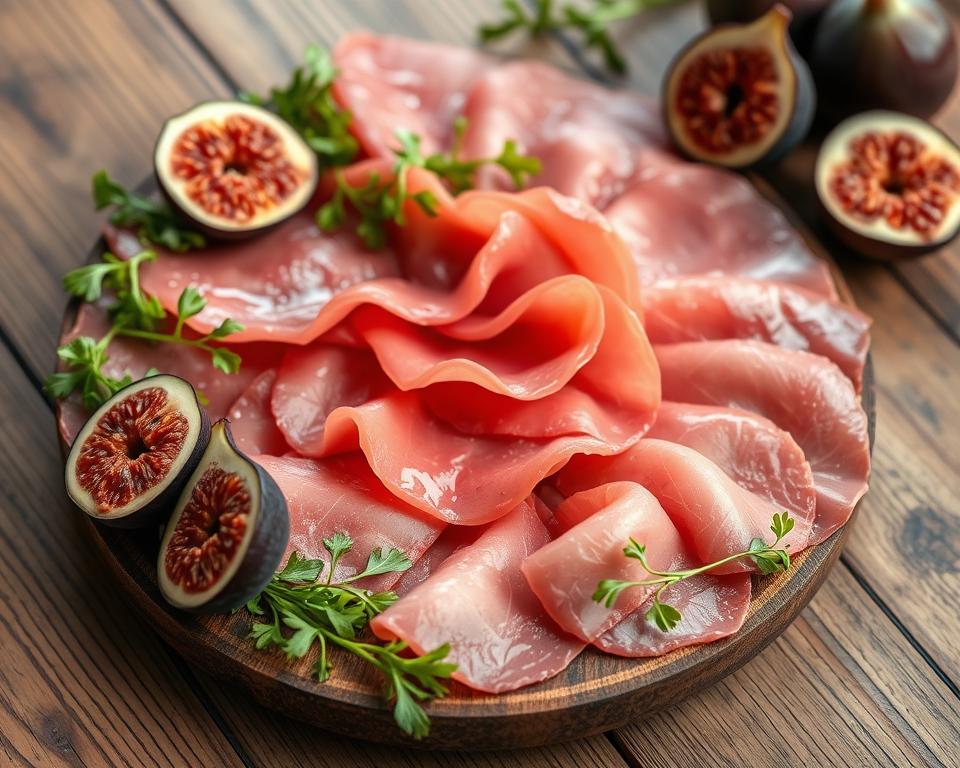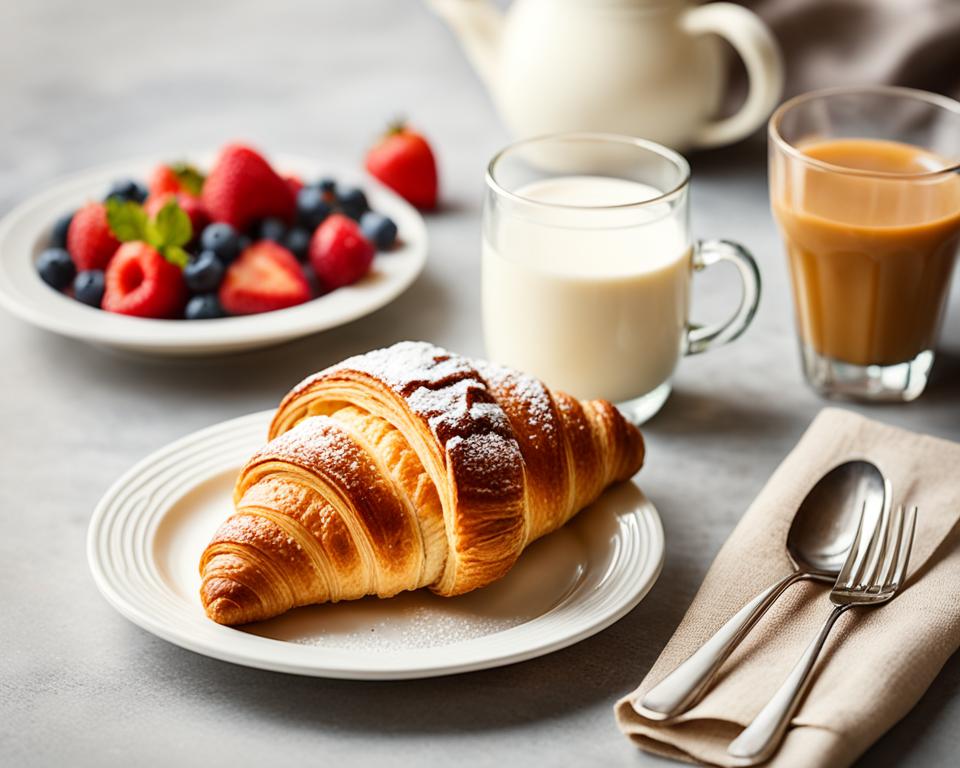Magret de canard is a top French dish. It’s the amazing breast of the moulard or muscovy duck. This guide will help you make a mouthwatering meal. It’s perfect for anyone interested in French cooking, from beginners to experts. You’ll learn how to sear the duck breast perfectly for an amazing meal.
Read interesting things at : trainwithnexus
Key Takeaways
- Magret de canard is a prized French delicacy made from the succulent and flavorful breast of the moulard or muscovy duck.
- This recipe showcases the exquisite taste and texture of magret de canard, seared to perfection for an indulgent culinary experience.
- The guide provides step-by-step instructions for creating a delicious magret de canard dish that will impress your guests.
- Whether you’re a seasoned home chef or new to French cuisine, this recipe is suitable for all skill levels.
- The key to success is understanding the proper techniques for searing and preparing magret de canard.
What is Magret de Canard?
Magret de canard is the tender breast of the moulard or muscovy duck. It’s a prized delicacy in French cuisine. These ducks are grown for their succulent meat. The magret is known as the best part of the duck.
Defining the French Delicacy
The term “magret de canard” means a duck breast of high quality. It’s prepared with care, making it a sought-after dish. In France, it’s famous for offering an indulgent feast.
History and Origins
In the southwest part of France, moulard and muscovy ducks have a long history. Breeders have raised these ducks for centuries. Their meat is carefully grown to make the known magret de canard, a favorite in French cuisine.
Magret de Canard: A Culinary Delight
The magret de canard is the succulent breast of the moulard or muscovy duck. It’s well-known for its wonderful taste and feel, a favorite among food lovers. The duck breast has a layer of duck fat that’s very rich. This fat melts in your mouth. The duck meat itself is deep and savory. When you cook it right, the outside gets a tasty, crispy layer. Yet, inside it stays soft and juicy.
Exquisite Flavor and Texture
This magret de canard stands out for its taste and feel. Its marbling and how it’s cooked makes it a top choice. You get a mix of crispy and soft when you bite into it. Each bite is a perfect combo of textures and tastes.
Nutritional Benefits
Besides being tasty, the magret de canard is also good for you. It’s a great source of lean protein. This duck breast is full of important vitamins and minerals. The duck fat has healthy fats. So, having it now and then can be good for a healthy diet.
Choosing the Perfect Duck Breast
When picking the right
magret de canard
, think about the duck type and quality signs. The main types for
magret de canard
are the
moulard duck
and the
muscovy duck
Moulard vs. Muscovy Ducks
The moulard duck comes from crossing Muscovy and Pekin ducks, making it bigger and stronger. The muscovy duck, in contrast, is a unique kind prized for its tasty meat. While both types can make great magret de canard, they may vary in feel, fat, and taste.
Quality and Freshness Indicators
To know if a magret de canard is top-notch, look for a plump, solid, evenly toned breast. It should have a thin layer of white fat. The skin must be smooth and without marks, a sign it’s fresh. The meat should look bright and smell like duck, not bad.
| Indicator | Moulard Duck | Muscovy Duck |
|---|---|---|
| Size | Larger and more robust | Smaller and more compact |
| Texture | Tender and juicy | Firm and meaty |
| Fat Content | Higher fat content | Leaner with less fat |
| Flavor | Richer and more pronounced | Deeper and more gamey |
By knowing how moulard and muscovy ducks vary, plus what to look for in top quality and freshness, you can wisely choose the perfect magret de canard for your dish.
Preparing Magret de Canard
Getting the perfect magret de canard ready, a prized duck breast from France, is a special task. You need the magret de canard, salt, and pepper as must-haves. But, to really bring out the taste, try adding fresh herbs, garlic, shallots, and a bit of honey or brown sugar.
Essential Ingredients and Equipment
Here’s what you’ll need for great magret de canard:
| Ingredients | Equipment |
|---|---|
|
|
Scoring and Seasoning Techniques
First, it’s key to score and season the magret de canard right. Scoring the skin helps it get crispy. Add plenty of salt and pepper, plus herbs, garlic, and shallots for flavor. You can also sprinkle honey or brown sugar on top for extra taste.
Searing the Magret de Canard
The secret to a tasty magret de canard is in the searing. Searing makes the outside crispy and golden while keeping the inside juicy.
Achieving the Perfect Crust
To get a perfect crust, your pan or grill must be very hot. High heat makes the fat on the duck breast melt and sear nicely. Always dry off your magret de canard with paper towels. Then, season with salt and pepper. This step is key; too much moisture stops the crust from forming.
Temperature and Timing Considerations
The best searing temperature for magret de canard is around 450°F to 500°F. This heat quickly browns the skin without drying out the meat. Cook for 3 to 5 minutes on each side. When the outside is golden and reaches 130°F inside, it’s medium-rare and ready to eat.
Confit Preparation Method
Aside from the usual searing, magret de canard can be made through the classic French confit way. The word ‘confit’ means to preserve. It’s a slow-cooking method that not only keeps the duck tender but also rich in flavors.
Traditional French Technique
The confit style hails from the Gascony area of France. It’s a cooking secret passed down for many generations. Here, the magret de canard is cooked by itself, slowly, in duck fat. This low heat process makes the meat super tender.
Preserving Flavors and Tenderness
Dunking the magret de canard in duck fat and cooking it gently does wonders. The meat drinks up the flavors of this time-honored French way. The end result is a meal fit for a king. A duck breast that’s so soft, it almost melts in your mouth.
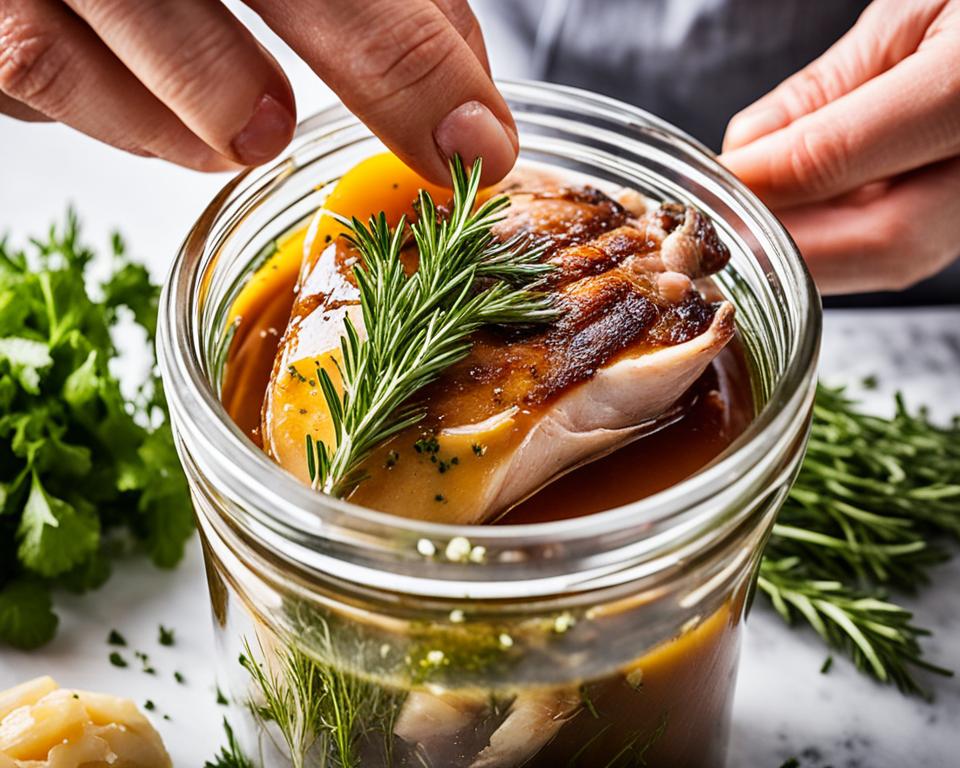
Serving and Pairing Suggestions
Magret de canard is known for its rich and succulent flavor. It pairs well with many side dishes and drinks. This combination makes for a truly special meal.
Complementary Side Dishes
Enhance the taste of magret de canard with sides that complement it. Here are some great options:
- Roasted potatoes or pommes de terre sarladaises (potatoes cooked in duck fat)
- Sautéed green beans or asparagus with shallots and garlic
- A fresh, crisp salad with a light vinaigrette
- Buttery mashed potatoes or purée de pommes de terre
- Braised red cabbage or chou rouge braisé
Wine and Beverage Pairings
Pick a bold, full-bodied red wine to go with the duck, like Bordeaux or Cabernet Sauvignon. Their tannins and acid can balance the rich flavor. Or, choose a lighter wine like Pinot Noir or Merlot.
For those who don’t drink alcohol, strong French press coffee or dark hot chocolate is a great choice. Or, end your meal with a glass of vintage Armagnac or Cognac for a special treat.
| Beverage | Pairing Notes |
|---|---|
| Bordeaux | Tannins and acidity in Bordeaux help balance the duck’s richness. |
| Malbec | Malbec, with its bold fruit and smoothness, pairs well with magret de canard. |
| Cabernet Sauvignon | Choose Cabernet Sauvignon for its strong tannins and fruit flavors. It’s a classic match for the duck. |
| Pinot Noir | A lighter Pinot Noir contrasts the duck’s flavors beautifully. |
| Merlot | Merlot’s silky texture and fruity taste make it perfect for magret de canard. |
Magret de Canard in French Cuisine
Magret de canard is a favorite in French cooking. It’s enjoyed all across the country, each region adding its special touch. Thanks to this, the dish shows off duck breast in various delicious ways.
Regional Specialties and Variations
The Périgord area stands out for its duck and goose dishes. Here, magret de canard comes with a tasty sauce. This sauce is made with duck fat, shallots, and sometimes Armagnac.
Heading north, to Alsace, you might find a sweeter magret de canard. It could have honey glaze or fruit compote. These sweet additions perfectly balance the duck’s savory flavor.
In Normandy, magret de canard might be served with a cider sauce. This sauce highlights the area’s apple orchards and cider. It makes for a unique, tangy taste.
Every regional take on magret de canard honors the main ingredient. They all aim to bring out the duck’s best flavors. Thus, they show the wide range and creativity in French cooking.
Exploring Duck Fat Renderings
When you cook magret de canard, you get a special bonus – duck fat. This fat is more than just tasty. It has a lot of culinary uses and some great benefits. It’s a key part of the duck breast experience.
Culinary Uses and Benefits
The duck fat you collect is like gold for cooks. It brings a rich flavor and silky feel to food. Use it when roasting potatoes or sautéing veggies. Even the simplest meals get a gourmet touch with it.
But duck fat isn’t just delicious. It’s also good for you. It has good fats and is packed with antioxidants. Plus, it stands up to high heat without burning, perfect for frying and searing.
Storage and Handling Tips
Storing duck fat right keeps it fresh and ready to use. After cooking, cool the fat a bit. Then, pour it into a container and chill. It will last about 6 months in the fridge. When cooking, let it warm to room temp for easy use.
Using duck fat helps cooks create amazing magret de canard. It opens up a world of flavors. This fat adds a rich taste and texture that’s hard to beat.
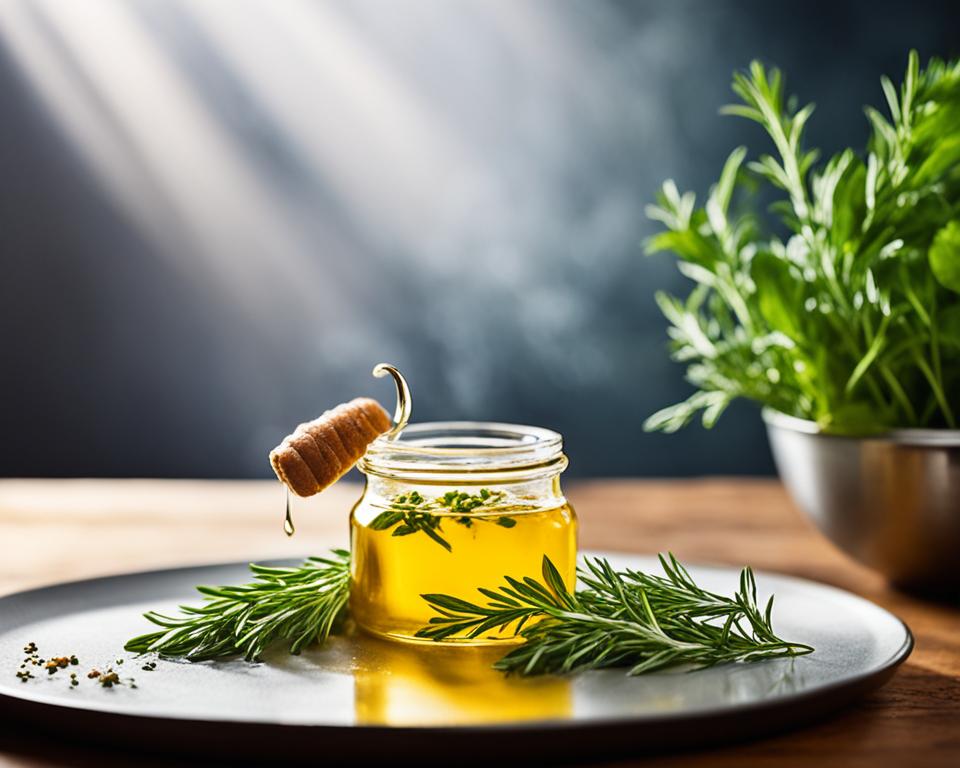
Mastering Gourmet Cooking with Duck
Learning how to cook magret de canard opens doors to more gourmet meals with duck. You can up your cooking game and dazzle everyone with amazing dishes. This is all about using the right methods and ways to serve food.
Techniques and Presentations
Pros know that cooking magret de canard is not just frying. It’s about little details and knowing the meat well. With the right techniques, you make perfect meals. And you get to be creative with how you show off the duck’s great taste and look.
Elevating Your Culinary Skills
Getting good at gourmet cooking with magret de canard is big for your cooking skills. You’ll learn to play with flavors and improve your meals big time. Your friends and family will be amazed. Plus, you’ll want to keep getting better at cooking.
Delicious Magret de Canard Recipes
Looking into magret de canard recipes uncovers a wide culinary world. You can find classic French dishes and new contemporary twists. These recipes are perfect for anyone wanting to try something new or stick to the classics.
Classic French Preparations
The French truly know how to cook magret de canard well. Their traditional ways highlight the duck’s natural flavor and tenderness. From seared magret de canard to confit de canard, these dishes are the heart of French food.
Contemporary Twists and Fusions
Even though classic dishes are popular, some chefs get creative. They add new twists and fusion recipes to magret de canard. These new styles mix in global flavors. They can include different ingredients and cooking methods for fresh, exciting meals.
Health and Sustainability Considerations
When we enjoy the delicious magret de canard, we should think about our health and the environment. It’s important to choose it wisely and eat it in moderation. This helps ensure we’re making good choices for both our bodies and the planet.
Responsible Sourcing and Production
Choose magret de canard from ethical farms. These farms care about the animals and the Earth. Make sure the duck meat you buy has certain labels. This shows the duck lived well and ate a natural diet.
Eating from ethical farms supports better food practices. This means you can savor magret de canard with a clear conscience.
Moderation and Balance
The taste of magret de canard is rich and tempting. But, remember to eat it in moderation. This is because it’s high in fat.
Pair magret de canard with lots of veggies, grains, and other lean proteins. This ensures your meals are healthy and balanced.
Cooking Tips and Troubleshooting
To make a perfect magret de canard, avoid common mistakes and use expert tips. Knowing how to sear the duck breast and get it tender is key. It turns a simple dish into something really special.
Common Pitfalls and Solutions
The challenge in making magret de canard is the perfect sear without tough meat. Too much heat or time dries it out. Watch the temperature and time closely. It should be hot enough for a crisp but not to overcook inside. Scoring the skin and drying the duck breast help the fat cook evenly and the meat stays moist.
Expert Advice and Tricks
Top chefs have special tips for magret de canard. They suggest salting it lightly and air-drying it in the fridge for a few hours. This makes the skin extra crispy. Basting the duck with its own fat while cooking keeps it tasty. Letting it rest before slicing spreads the juices for better flavor and tenderness.
